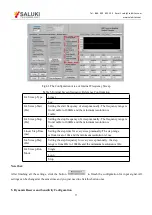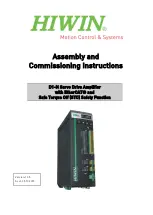
Tel: 886. 909 602 109 Email: [email protected]
www.salukitec.com
67
9
θh1
10
Xh2
11
Yh2
12
Rh2
13
θh2
14
Noise
15
A1
16
A2
17
A3
18
A4
19
E1
20
E2
21
E3
22
E4
The requested values are returned in a single string with the values separated by commas
and in the order in which they are requested. For example, the SNAP?1,2,5,4 will return the
values of <X>, <Y>, <Frequency> and <θ>. These values will be returned in a single string
such as "0.951359,0.0253297,1000.00,1.234". The first value is <X>, the second is <Y>,
the third is <Frequency> and the fourth is <θ>.
The SNAP? command is only used to record various parameters simultaneously.
SPTS?
The SPTS? command queries the number of points stored in the buffer. This command can
be sent at any time. If the data buffer is reset, then 0 is returned. This command is a query
only command.
TRCA?i,j,k
The TRCA? command queries the data (Buffer1 to Buffer 4) in the channel i Buffer.
The values are returned as ASCII floating point numbers with the units of the trace.
Multiple points are separated by commas (,) and the final point is followed by a terminator.
For example, the response of two points might be “-1.234567e-009, +7.654321e-009”.
The parameter i selects the display buffer (i=1,2,3,4) and is required to send with this
command. Points are read from the buffer starting at bin j (j
≥
0); A total of k bins are read
(k
≥
1); To read a single point, set k=1. Both j and k are required. If j+k exceeds the number
of stored points (as returned by the SPTS? query), then an error occurs. So, the value of j+k
should be no more than 16384 which is the maximum number of data stored in the buffer.
4.2.10 Reset and IDN Commands
RST
The RST command is used to reset SE1022 to its default configurations. All internal status
and parameters are set to their default conditions and values. Data stored in the buffers will
be lost.
















































